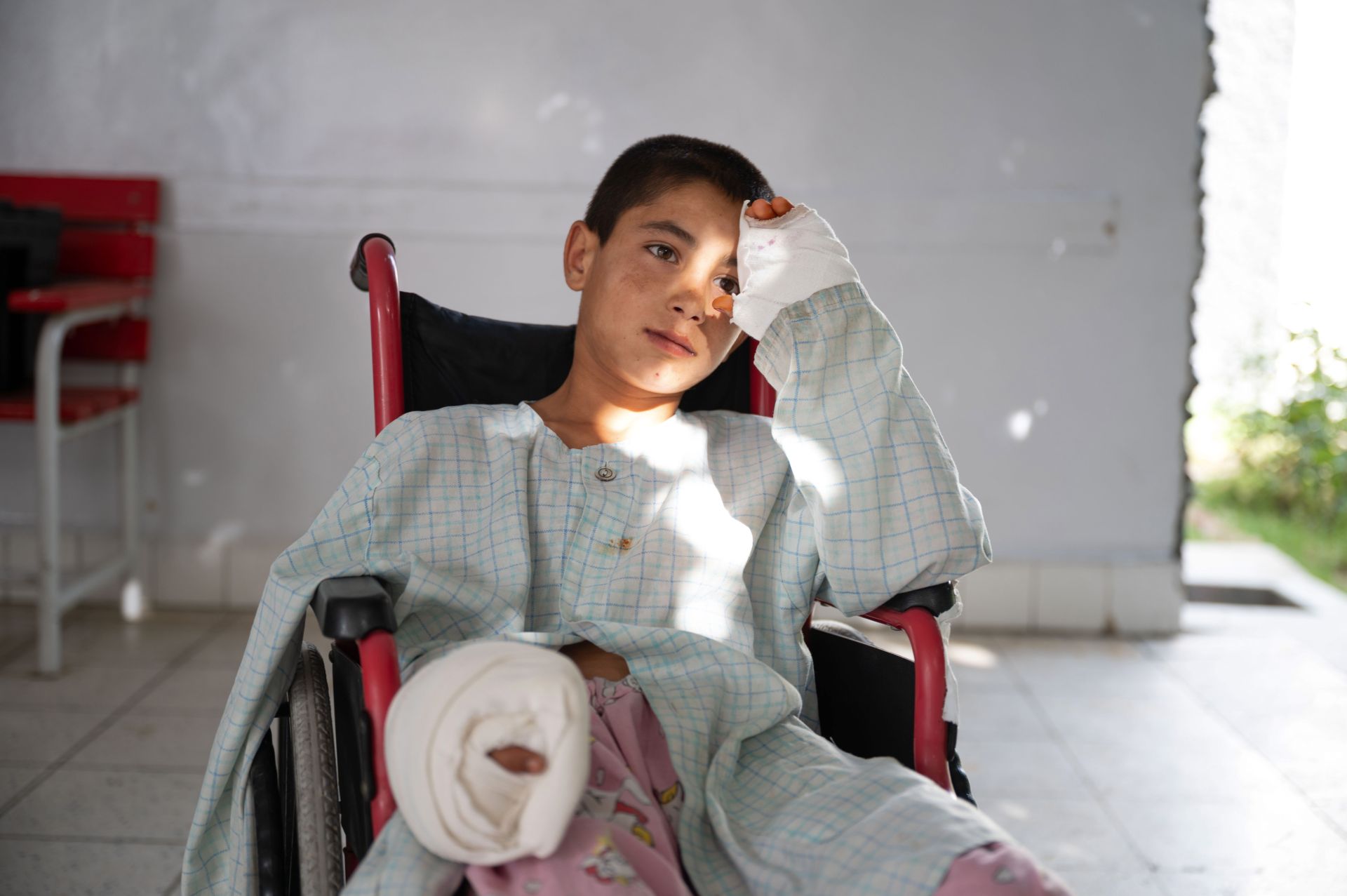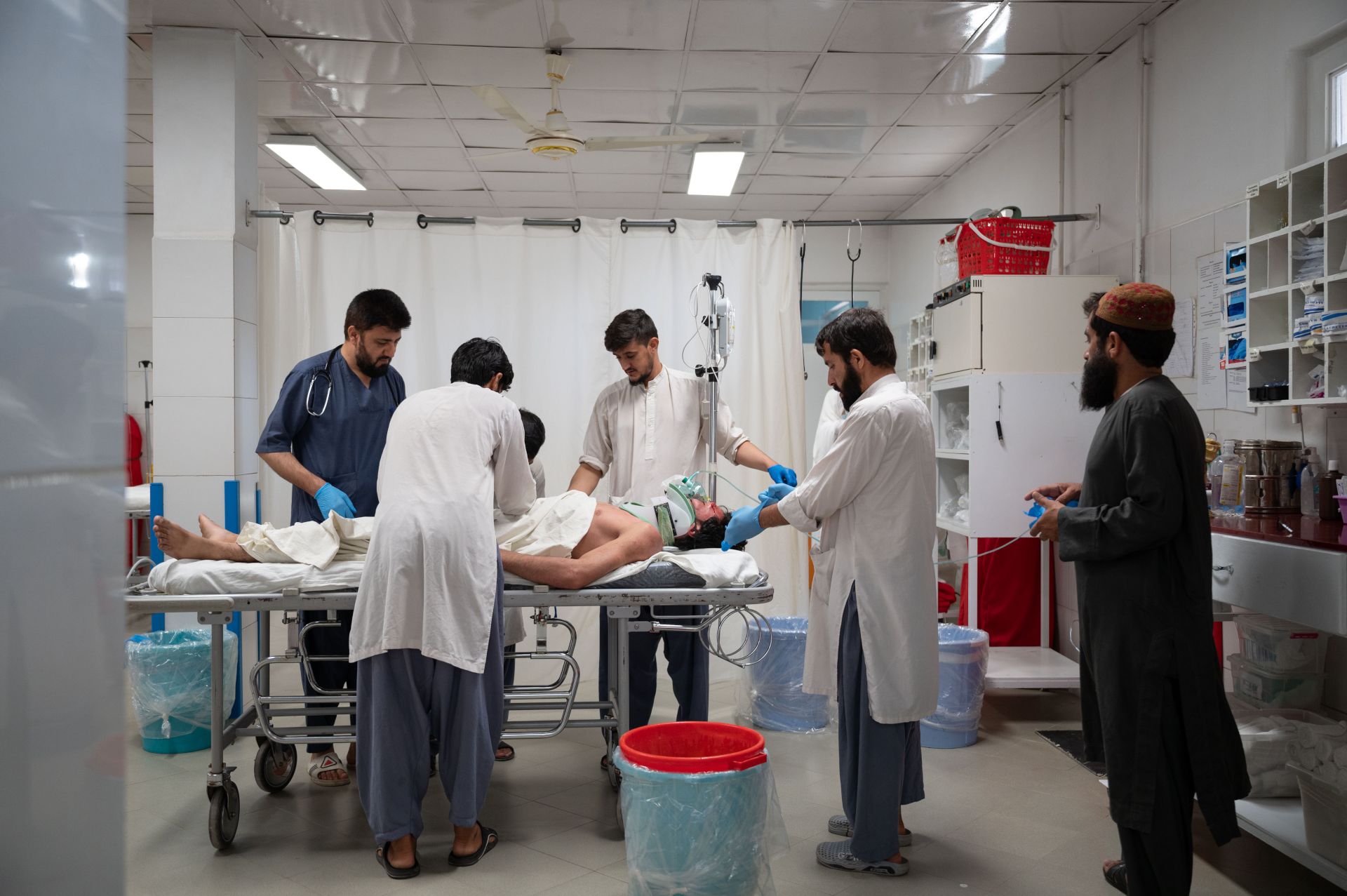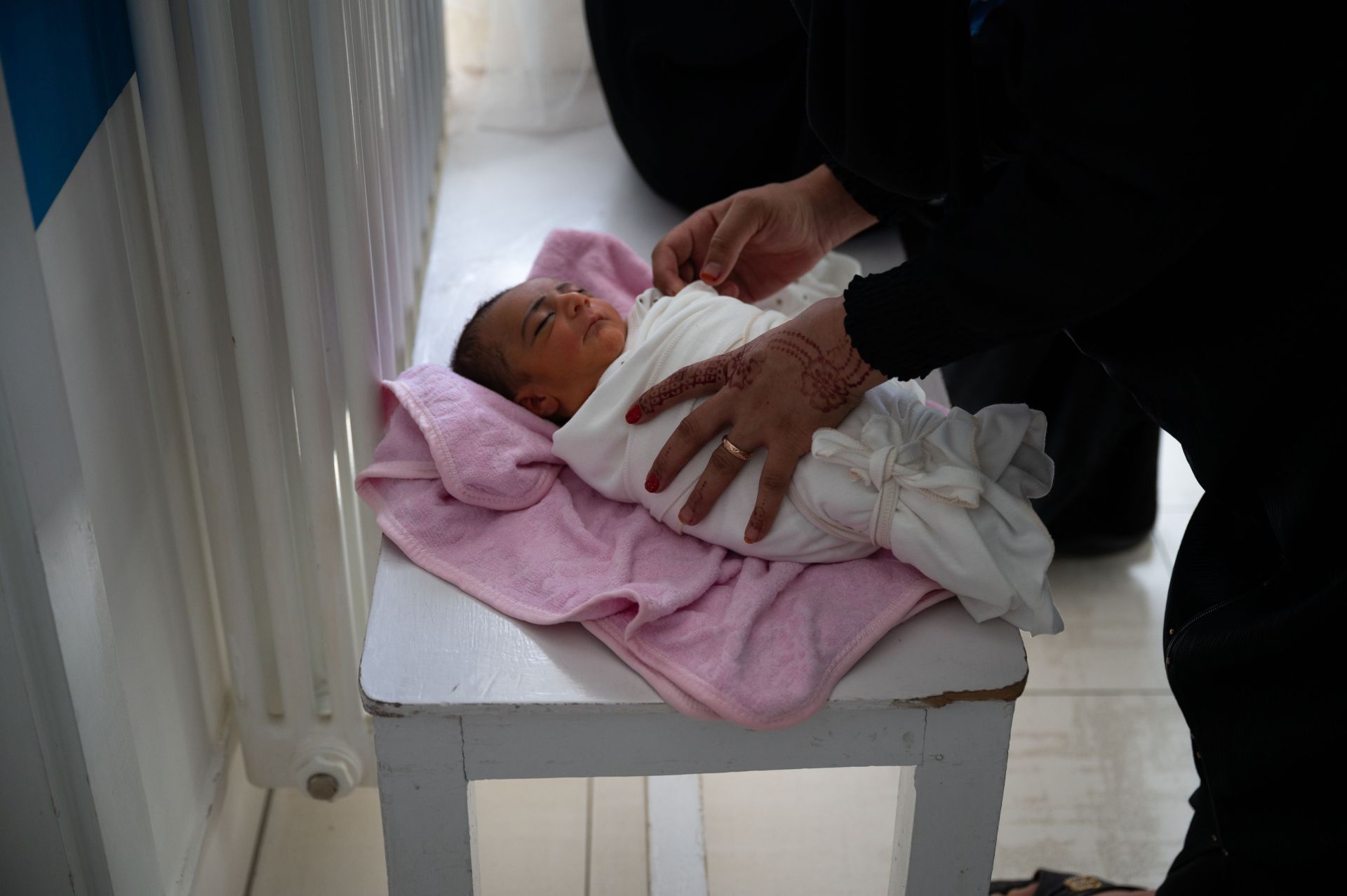Outside the boys’ ward of a Kabul hospital, 8-year-old Rahmanullah watches the rose bushes nod in the dry breeze. One hand rests carefully in his lap, the other idly turns over a battered mobile phone. The screen is cracked, the buttons worn smooth. His father, he says, calls every day from his home in Paghman district, west of Kabul.
Three days earlier, Rahmanullah arrived here, bleeding and dazed, cradled in the back seat of a car. A mine had gone off in his hand when he was collecting scrap metal with his father and brothers in their village of Zarshakh.
“A boy gave me something that exploded in my hand,” he tells me, his voice catching somewhere between confusion and certainty. He glances down at the bandages that wrap the lower half of his arms. “My finger is missing.”
He remembers a stranger tightly binding his wrist with a handkerchief, an improvised triage in a place where first responders are often simply whoever is nearby. “I cried when I saw the blood. I sent a boy to tell my father. They brought a car, then they took me to the hospital.”
He still doesn’t know what exploded in his hands. Perhaps a shell, or an old mine. His older brother, he adds matter-of-factly, lost two fingers three years ago while searching for scrap in the same way.
Inside the hospital, amid the low hum of the TV showing “Shrek” and the distant shuffle of rubber soles, Rahmanullah looks out past the roses, patiently waiting for the next call from his father.
Tucked behind thick concrete blast walls, the hospital feels like another world — a serene oasis in a city scarred by war. It is a place of pause and healing, where the wounded are not only stitched and medicated, but reminded, however briefly, of life beyond their wounds. Behind the hospital’s shrapnel-pockmarked walls, the garden quietly pushes back against the destruction. Roses bloom — bursts of pink and red in neat rows. Birds flit between the branches. On Saturdays, benches fill with mothers cradling infants and old men offering sweets to grandchildren. In between, in the shaded walkways, nurses catch their breath against the cool tiled walls.
Here, the cacophony of Kabul fades — the hum of distant traffic and the echo of sirens recede into the background, replaced by birdsong and the soft rustle of leaves in the breeze.
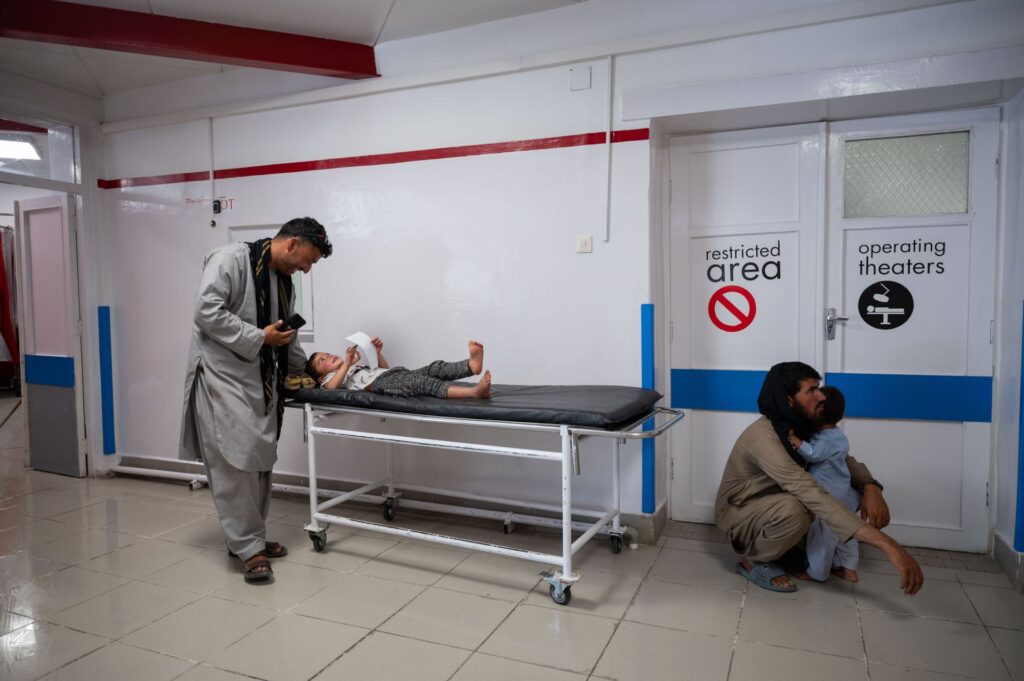
Four years after the U.S. war ended, Afghanistan is gripped by one of the world’s worst humanitarian crises. More than 23 million people — nearly half the country — now rely on aid just to access food, clean water or basic health care. Since the Taliban’s return to power in 2021, the country’s fragile health system has been teetering on the brink: International aid has all but dried up, and clinics across the country have gone dark.
And while fighting no longer rages, for Afghanistan’s doctors, emergencies persist — though they have changed shape as new health needs emerge. Once overwhelmed by the pace and brutality of battlefield trauma, medical staff are now adapting to new but equally formidable demands as the social fabric frays under the rule of the Taliban, whose draconian restrictions on women have isolated Afghanistan from the rest of the world.
Doctors at hospitals and clinics belonging to Emergency, an Italian medical nongovernmental organization that has operated in the country for a quarter of a century, treat a deluge of road traffic accidents, stabbing injuries, gunshot wounds and other civilian traumas, including those involving complications arising from long-neglected care needs.
“In some ways, it is still ‘business as usual’ — we continue to treat the most critical patients, whether referred by other hospitals or arriving directly at our doors. We see violent injuries, including stab wounds, single gunshot wounds and injuries caused by unexploded ordnance,” Dejan Panic, Emergency’s country director in Afghanistan, tells New Lines.
Until January of this year, the U.S. Agency for International Development (USAID) provided nearly 40% of Afghanistan’s foreign health assistance. The abrupt slashing of USAID funding by the Trump administration has left a gaping void. By June, over 425 Afghan health facilities were believed to have shuttered, according to the World Health Organization.
At Emergency’s hospital in Kabul — one of the last surgical centers still running with international support from a mix of private and institutional donors — the criteria for admission have shifted, just as the context has. “We do not receive direct USAID funding, but we are indirectly affected because certain provinces have been left without basic and essential services, putting greater strain on the country’s health system. Patients are traveling for hours to be seen in our clinics,” Panic says.

“There are fewer mass casualty incidents and attacks, and our trauma hospitals — particularly in Helmand — are increasingly treating civilian cases such as road traffic accidents and occupational injuries,” Panic says.
On top of this, people are traveling more and in greater numbers, often by bus, which increases risks and admissions. “What’s changed is that these accidents are now more visible to us. In the past, despite high rates of road traffic incidents, our hospitals couldn’t admit many civilian trauma cases due to limited capacity,” he adds.
Though the fighting has largely ceased, the lingering dangers of explosive remnants of war (ERW) persist. The U.N. reports that two-thirds of Afghanistan’s 400 districts are affected by explosive hazards left behind by decades of successive conflict. From 2001 to 2023, Emergency treated 29,759 mine and shell injuries. Today, the hospitals continue to treat mine and shell injuries every day, particularly among children. Nearly 400 such cases were documented in the past year alone.
In Afghanistan, 8 out of 10 victims of explosive devices are children. More than half of the explosions happened when they were playing, according to U.N. data from December 2024.
Every day, young children arrive at the hospitals with such injuries. These children speak candidly about not knowing that the objects they picked up were mines. Some are too young to even understand what a mine is. Many know of other children who had also been injured by mines and shells.

In the afternoon, six siblings, aged from 5 to 13, arrive at the Kabul center with severe burns sustained from a mine. According to their father, a man had given the children the mine while they were collecting bottles for recycling.
Ten-year-old Nasratullah lost two fingers when a mine exploded in his hand. He traveled by ambulance from Gardez in Paktia Province to the Kabul center. He recalls playing with some children near his house. “I picked up a mine with my hands. The bomb exploded. I was injured here,” he says, pointing to his bandaged hand. “The bleeding wouldn’t stop. I ran to our house.”
Nasratullah is on the same ward as 13-year-old Abdullah, also injured by a mine. “My grandfather, my brother and I wanted to pick apricots from the garden. Then the mine exploded on me,” Abdullah says. His grandfather and brother did not survive the blast.
Not only have these children’s lives been irrevocably altered by the physical and psychological trauma of losing a body part, but sometimes their parents do not even come to pick them up from the hospital. An amputation of a hand or leg can represent an immense loss not just for an individual, but for their entire family. A child may struggle to find work, support themselves and their family, and be fully accepted as a strong and capable person in society.
The three hospitals I visit treated over 1,000 stabbing cases and 674 bullet wounds over the last year alone. Abdul Wakil worked as a nurse in the operating theater in Kabul for 18 years until he was shot in April 2023. “I was hospitalized on the operating table that we use for patients. My colleagues started working on me. I was in a very bad situation, in spinal shock. I was in the ICU for two nights and two days, and when I woke up I found out that my legs were paralyzed,” he says.
A year earlier, in 2022, his colleague at the Kabul surgical center, Bahlool, was shot and killed — another victim of continued gun violence across the Afghan capital.
When 10-year-old Nasir was shot in the leg near his home in Nangarhar province, local doctors amputated — then sent him on his way. Sixteen hours later, he arrived at the Kabul Surgical Center. There, doctors worked through the night to undo the damage of the rushed surgery and save his life.
“I was sitting next to a stream when I saw two guys fighting. They were shooting, so I looked. I was shot in the leg,” he says, “I was bleeding, then I stood up, started running and fell. After that, I fainted. My uncle came, picked me up, and brought me to the hospital by car. When I arrived here, my leg was amputated. Now I am very happy. I survived. Now I am fine. Now I can walk,” he says, gesturing to the crutches he received.
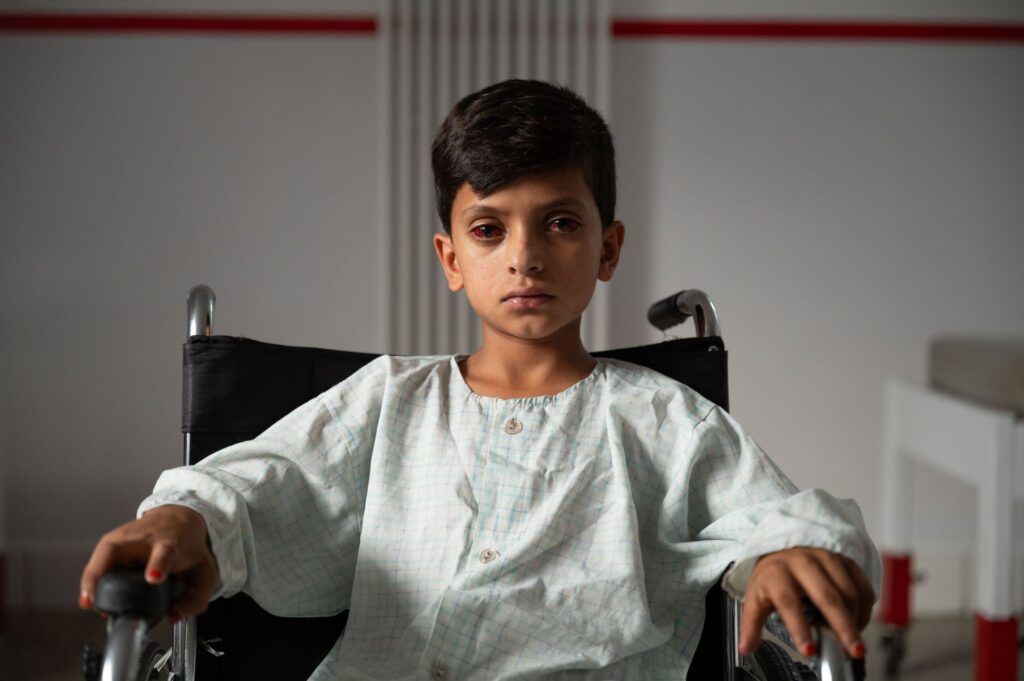
In 2004, the Lashkar Gah Surgical Centre for War Victims opened in Helmand province, one of the most volatile regions in the country. It is the only specialist war surgery center for the entire southern region. Between 2004 and 2021, tens of thousands of war-wounded were treated at the hospital. Over 30% of patients admitted are under the age of 14.
Trauma surgeons with 20 years’ experience managing hundreds of mass casualty events from coordinated suicide bombings — sometimes two or even three in a single day — now face a surge of complex, noncombat injuries.
According to Gulbaddin, the head nurse at the bustling outpatient department in the Lashkar Gah center, patients are coming to the hospital around the clock. “Now that the roads are open, the patients are arriving at all hours of the day and night. They are coming by car, by motorbike, any way they can, they are coming.”
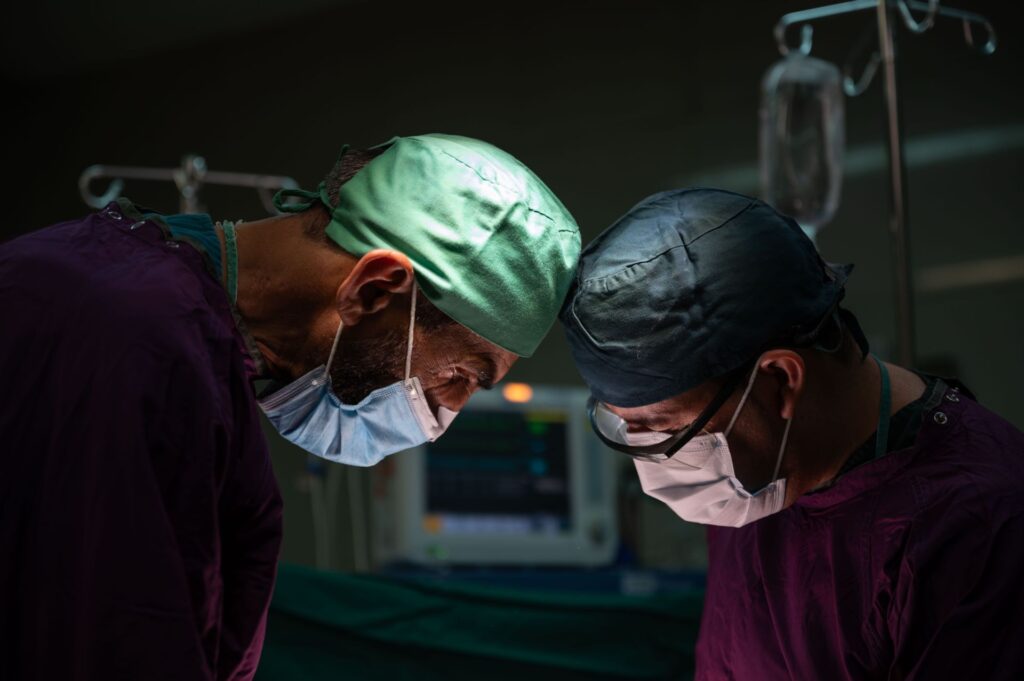
With fighting no longer dominating the landscape, other public health crises are coming into sharper focus — and doctors find themselves tackling new emotional and ethical complexities that are now emerging in their operating rooms.
One of the most urgent and deeply troubling shifts is domestic and familial violence. Under Taliban rule and amid severe economic strain, violence within households now reaches the hospitals’ doors on a daily basis. Medical professionals are seeing an increasing number of patients — especially women and children — who arrive at hospitals with injuries caused by their own family members.
The patients’ medical cases are often complicated, both medically and ethically. In Kabul, I meet an 8-year-old girl who has been shot in the arm by her father. Each morning, she makes her way to the physical therapy room, where — under the quiet guidance of specialists — she moves through a series of exercises and stretches, small rehearsals for the life she will eventually return to. She hasn’t spoken about what happened, the staff tell me. No one from her family has come to visit.
In another case, a man was brought into the outpatient department with a crushed skull, only for doctors to learn that the injury had been inflicted by his relative — the very man who brought him into the hospital.
On the women’s ward, a woman receiving fresh dressings shows me her chest, bearing eight stab wounds — injuries inflicted by her husband, she tells me. But with nowhere else to go, she is preparing to return home to him as soon as the nurses finish.
Seventeen-year-old Negar arrived at the Emergency Kabul center three years ago with a gunshot wound to the stomach. She had attempted to take her own life by shooting herself in the stomach with her late father’s hunting rifle, she tells me. Since then, she has been in and out of the surgical center. She says that she continues to suffer beatings at home, which reopen the wound, landing her back at the hospital. Some staff worry that she is tampering with the wound so she can come back.
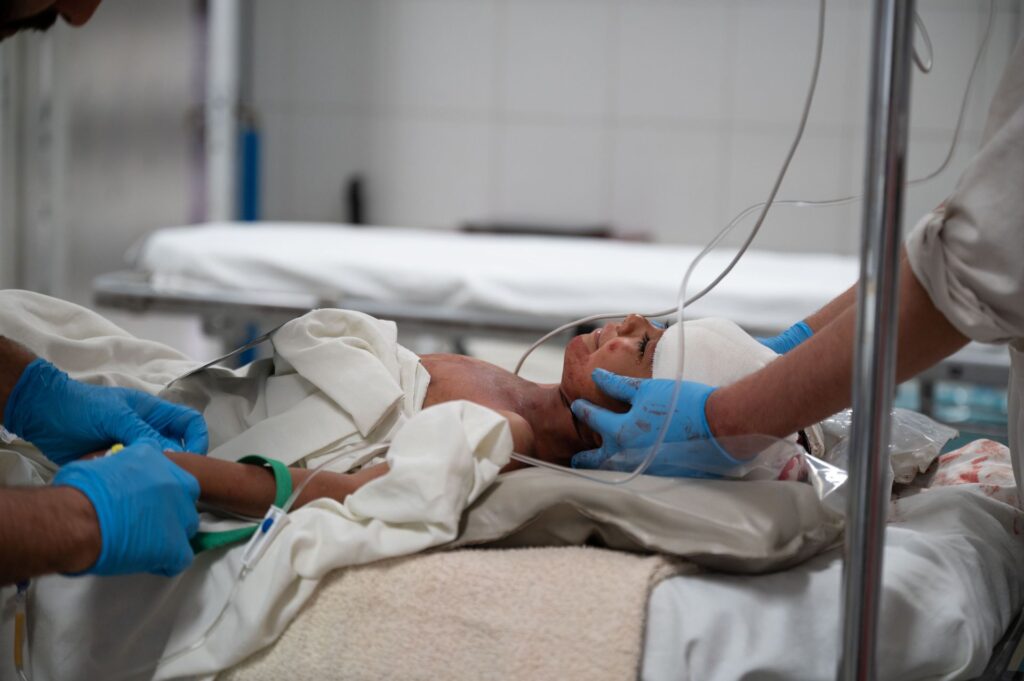
In Helmand, violence arrives in flurries. One afternoon, a man enters the outpatient department carrying his brother. They have stabbed each other during a fight at home. Their mother and one of their wives were also injured, trying to intervene. In the chaos of triage, one of the brothers goes into cardiac arrest and is rushed to the operating theater.
Later that evening, I see the surgeon in the corridor. He looks hollowed out.
“We did what we could,” he tells me. The stab wounds to the lungs had been bad, but survivable. It was the artery in the neck — ruptured mid-surgery — that they couldn’t stop. “We lost him.”
In a quiet ward at the far end of the hospital, 18-year-old Bashir and his younger brother are healing after multiple surgeries. A mine exploded while he was building his house. He suffered injuries to his body, arm and legs and lost sight in one eye. His younger brother is recovering from a severe head injury. After his father was killed during the war, Bashir was left as the sole provider for his 10 younger siblings. He was still just a boy himself. Now, wounded and uncertain of his recovery, the weight of that responsibility feels heavier than ever.
“The country is full of mines,” Bashir says, “every step you take could trigger a hidden mine.” The war is not over, he says; he and his brother were on their land, building a house, and they both thought it was a safe area.
“There have been not hundreds, but thousands of incidents.” He says that, while doctors are able to help some, many victims have lost arms and legs, or their lives. “If it had been a big mine, we wouldn’t have survived the journey to the hospital for treatment, we would have died on the spot,” he says.
“We’ve seen enough wars and mines — we don’t want any more. We want to reach the point where our children can go to school and become teachers and doctors, helping others and building their careers instead of fleeing from war, bullets and aircraft like we did.”
Despite the enormous emotional toll, Afghan doctors continue to serve their communities with remarkable resilience. Their work requires both surgical expertise and a heightened sensitivity to the social fabric unraveling around them. These physicians now navigate not just physical trauma, but also the psychological and societal breakdowns that accompany domestic violence, poverty and a lack of legal or protective infrastructure.
In the midst of Afghanistan’s economic crisis, even basic health care has become unaffordable for many families. But people still seek treatment at Emergency’s hospitals — for one reason: It’s free.
For women and girls, the barriers are higher, though. Already hardest hit by the health care crisis, they now face mounting restrictions on their movement, education and access to care.
Since returning to power, the Taliban have issued sweeping edicts that have systematically stripped women of their rights: Education has been halted beyond the sixth grade, NGO jobs banned and movement restricted. In 2024, the crackdown extended even further — women were banned from working in health care altogether. The U.N. warns that these policies will reverberate for generations. By 2026, it estimates, keeping 1.1 million girls out of school and barring 100,000 women from university could lead to a 45% increase in early childbearing, and maternal mortality could rise by as much as 50%.

Inside Emergency’s surgical centers, women are still learning, working and healing. The organization currently employs 380 Afghan women on its staff.
“Female staff — including nurses, midwives, resident doctors and specialists — are still able to work in our clinics and in our hospitals. Residency programs for female staff are also running in anesthesia, intensive care and gynecology and obstetrics,” Panic says. “The problem is that medical licences are obtained in an exit exam at the end of university, which is now closed to women. So all of the female staff entering our residency programs are those who passed the exam prior to August 2021.”
Emergency’s maternity center in Panjshir is exclusively female-run. But its 150 Afghan female maternity staff now struggle to cope with the number of patients, delivering up to 600 babies every month, whose mothers often come from hundreds of miles away.
“We have many patients coming from different provinces now, because every way is open, but we just don’t have enough midwives on staff, we are just not enough,” says Maria, a midwife at a maternity ward in Panjshir since it opened in 1999.
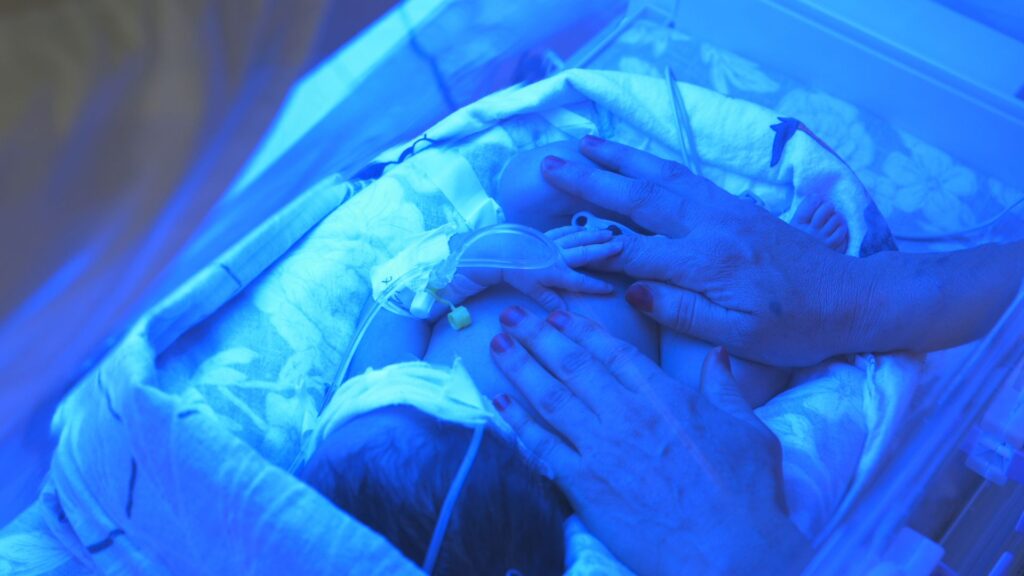
Samira works in the operating theater in Kabul, tending to the influx of patients who flood in after mass casualty events, including a suicide attack at the Ministry of Interior Affairs that saw her treat her own husband, a police officer. “I want the female patients to see that there is a female working here, I want them to feel safe,” she explains.
Samira views her presence as not just medical but symbolic. “Women should never think of themselves as weak,” she says. “Anything a man can do, we can too. When I started in the OR, I erased the words ‘I can’t’ from my mouth. Even if the work was difficult, my ability would increase, and I told myself, ‘I can.’ Because I am a woman.”
One of her patients is 10-year-old Afshaneh, who was admitted to a surgical center in Kabul after being shot in the abdomen. “In the room where I am, all the patients, young and old, are with me. Some of them were hit by a bullet, some were hit by a bomb, some were injured by a car collision,” she says. Their stories reflect more than individual tragedies — they highlight the importance of the evolving role of medical professionals in a country where a deep crisis continues, long after the fighting has stopped.
The gardens at Emergency’s Kabul hospital continue to bloom. Every flower a small but vital act of normalcy, of resistance and endurance, stitched into the fabric of daily life — a quiet way to remember the past, to survive the present and to dream, still, of peace.
Become a member today to receive access to all our paywalled essays and the best of New Lines delivered to your inbox through our newsletters.



